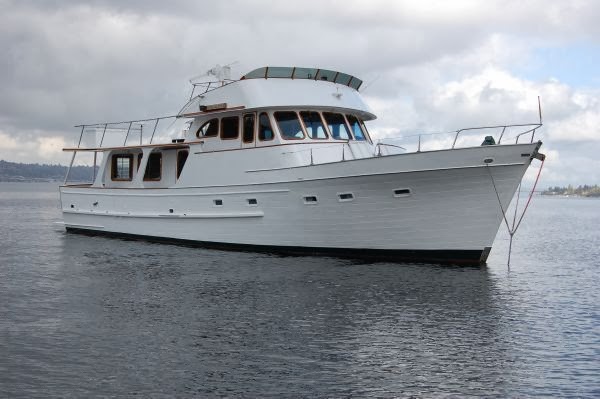After a week of finishing up some final projects, like mounting the cradles for my rowboat, making a cactus holder so my plants don't go flying, and filling up with fuel; we headed out on our first trip. We decided to go to Sucia because it's the first place we went with all of our previous boats. We left for Sucia on a beautiful sunny day with very little wind, and got there in about 3 hours after fighting a bit of current through hale passage. We towed Thumper behind us, and our hastily assembled towing bridle worked perfectly. The only problem we ran into heading to Sucia was that Misogi failed in her most basic purpose: she didn't keep the water on the outside. A bunch of seams above the waterline on the bow had dried out over the summer, and whenever we hit a wave or went faster than half throttle sea water poured in. This wouldn't have been a huge problem, but our forward bilge pump had blown out it's diaphragm, so we had no way of getting the water out again. By the time we got to Sucia we had a good 6 inches of water in the bilge. Sucia was as beautiful as always, with fantastic sandstone formations everywhere. The only problem was a huge mosquito population; walking around on the island was made fairly unpleasant by the little bloodsuckers, and by evening they had migrated out into the harbor and we had to shut all the doors and windows. We felt sorry for the people camping ashore.
 |
| Misogi Getting Fuel |
 |
| Cactus Holder |
 |
| Anchored at Sucia |
 |
| Cave |
 |
| A Very Small Beach |
Our first night at Sucia was rather entertaining. After a perfectly calm evening (during which we anchored with only 3:1 scope) a respectable 35-40 mph wind came up at about 1 am. Because Echo Bay is pretty exposed, we got rocked around a lot by large swells and Thumper kept getting caught under the rub rail. Nobody got much sleep. As it turns out, that was a good thing, because the combination of high tide and a particularly strong set of waves popped out the anchor at about 6 in the morning, and we went sailing across the anchorage. My dad was awake, so he got my mom and I up to start the engines and raise the anchor. My dad didn't want to re-set the anchor, so we tied up to the linear moorage and stayed there for the next day. We also found out that our anchor light and masthead light fixtures were both broken.
 |
| Broken Anchor Light |
 |
Windy (gold needle shows max. wind speed,
gauge reads about 5mph slow.) |
The next day, we took a hike out to Johnson point in the morning. There were some pretty amazing old growth madrone groves with trees several feet in diameter, and some great views. Surprisingly, despite there being around 30 boats in echo bay alone, we only ran into one other group hiking. We had the point to ourselves. By afternoon, the straits had calmed down enough to try a run to Patos in Thumper. It was a bouncy ride over, but we were able to drive right up on the beach and tie off to a fallen tree. Small boats are kind of convenient that way. Patos was a beautiful island with a very dense forest, a very cool rocky shoreline with a long shelf that collects intertidal critters, and a vast grass-covered point where the lighthouse is. Although only the lighthouse remains of what used to be a large compound with shops, cisterns, barns and a marine railway, there are ruins and crumbling foundations all over the north end of the island, which make for very good exploring. There is also a barn swallow colony living in the eves of the lighthouse, and they make their presence very well know if they are surprised. Barn swallows can be surprisingly intimidating if 20 of them are swooping within feet of ones face. Patos also has a straight concrete path built in the 1940's that is constructed just like a city sidewalk. It is surreal to walk around a mostly deserted island on a surface that feels like it should be in downtown Bellingham.
 |
| Madrone |
 |
| Lion's Manes |
 |
| Patos |
We worked out a temporary bilge pump for the return trip by taking out the floor in my bathroom and running a hose up into my sink. It turned out to be a good idea, because the water was still coming in pretty fast, and it kept too much of it from running back under the water tanks. Besides the leaks, it was a fairly uneventful trip light chop that bounced Thumper around a bit but had no discernible effect on Misogi. Getting into Bellingham bay was a bit exciting, because the entrance between Portage and Eliza was almost completely filled with crab pots. They were so close together that we had to pass less than 20ft away from a few floats, but thankfully they all used sinking line so we didn't wrap anything around our props or rudders.
 |
| Temporary Bilge Pump |
 |
| Bilge Water Going Down the Drain |
 |
| The Straits |
 |
| Serpentine Wake from Dodging Crab Pots |














